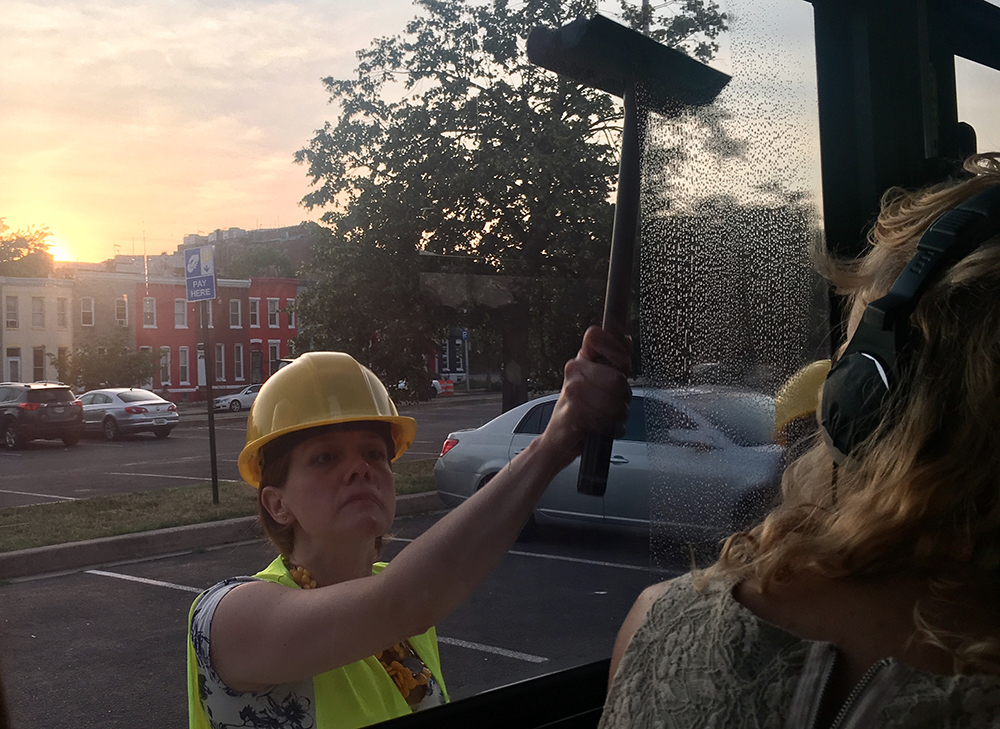
When Single Carrot Theatre artistic director Genevieve de Mahy was in Budapest in March of 2015, she saw an unforgettable performance that deeply connected her to the city.
She returned home where, a month later, Freddie Gray’s death lead to the city’s Uprising and de Mahy thought it was more crucial than ever to bring the performance to Baltimore.
“Freddie Gray’s death forced our city to take a good hard look at itself and confront its deep divides,” she said. “Our hope is that Promenade can deepen our connections to one another while questioning, challenging, and confronting the complex.”
Promenade puts its audience on a bus and has them travel around the city while listening to audio narration from both actors and city residents. When the audio tour starts out, the narrator proclaims: “Your city will never be the same as it is on this night” and reminds the audience to always be looking around.
While traversing the neighborhoods, Single Carrot actors play out scenes on the street. There are some subtle plotlines, but the performances act more like vignettes of typical city scenes: a woman sweeping her front walk, a postal worker delivering mail, a medical resident leaving work, or a reporter photographing a street performer.
The 95-minute show took passengers through Remington, Reservoir Hill, Bolton Hill, Greenmount, Waverly, Charles Village, Guilford, and back again. All the while, stories from Baltimoreans were playing through headphones—all of which rang true in one form or another. (“Some days Baltimore gives you a hug and others it punches you in the stomach.”)
“I interviewed nearly 40 Baltimore residents, attended community meetings, church services, and got walking tours of these neighborhoods,” de Mahy said. “We have had discussions as a group of artists and Baltimoreans sharing our own stories and perspectives.”
There was some chronology to the tour, as it started out by recounting the jazz age on Pennsylvania Avenue. A particularly poignant moment came when a resident talked about the glory days of the Royal Theater as the bus passed a mural depicting the theater alongside legendary musicians.
The music was another key element to the audio portion of the performance with selections from The Orioles, Wilson Pickett, Beach House, Future Islands, Matmos, and Lake Trout. Each song was perfectly curated for the atmosphere of the scenes just outside the bus windows.
Promenade perfected the art of timing, too, as the audience would hear a car horn play just as a near-crash happened outside or the bus would turn out of Guilford onto Greenmount Avenue as a local resident chimed in: “Baltimore can change on a dime.”
As the bus weaved its way up North Avenue past the Howard Street bridge, the story turned to the 2015 Uprising and how some residents were shocked by what happened in their city, while others were less surprised that it had come to a head. “People said they couldn’t believe communities were destroying their own property,” one man said. “But they never owned anything in the first place.”
It should be noted that there were certainly moments of discomfort viewing the city on a bus while wearing headphones that could have veered toward the exploitative. But, in contrast to the shameless Wire tours that went on a decade ago, Promenade provides context and relevance for those complex feelings, which results in a genuine appreciation of Baltimore—the good, the bad, and the ugly.
And while the Promenade: Baltimore production, actors, and audio were all stunning (and an incredible logistical feat), the most brilliant part was perhaps just observing the city with new eyes. On a pleasant summer night, plenty of people were out on the stoop, running on the playground, playing on the basketball court, or hula-hooping in the park. There was nothing incredible going on outside the bus windows, but that was just it.
The entire performance reminded the audience of the beauty—and the occasional heartache—of the ordinary.
